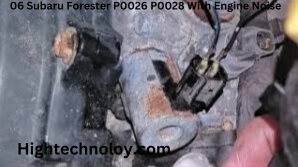06 subaru forester p0026 p0028 with engine noise.So, you’re cruising down the road, maybe jamming out to some tunes, and out of nowhere, that dreaded “Check Engine” light decides to ruin your day. Great. And just when you thought your 2006 Subaru Forester was going to be trouble-free for a while. You check the codes, and boom, you’re hit with P0026 and P0028. Oh, and let’s not forget the subtle (or maybe not-so-subtle) engine noise that’s been creeping in.
Yeah, I’ve been there. It’s not exactly a “Let’s have a relaxing weekend” moment, right? But, hey, let’s dive into this together. Grab a cup of coffee (or whatever keeps you going) and let’s chat about what these codes mean, what that pesky noise might be, and how you can fix this without pulling your hair out.
What the Heck are P0026 and P0028?
First things first, let’s decode those codes. P0026 and P0028 are related to the variable valve timing (VVT) system in your Subaru. Specifically, P0026 refers to an issue with the intake valve control solenoid circuit (Bank 1), and P0028 means there’s a problem with the intake valve control solenoid circuit (Bank 2). Sounds fancy, right? It basically means the car’s brain (the ECU) isn’t happy with how the intake valves are being controlled.
Now, you might be thinking, “Okay, cool, but why should I care?” Well, when your intake valves aren’t opening and closing at the right time, your engine doesn’t run as efficiently. That means rough idling, weird noises, and potentially some performance issues—like sluggish acceleration or the car feeling like it’s just not in the mood to move as smoothly as it used to.06 subaru forester p0026 p0028 with engine noise.
Read More:The Ron Perkens System: An In-Depth Analysis
The Engine Noise: What’s That About?
Ah, the engine noise. I like to call it the “Subaru Symphony,” but not in a good way. If you’re hearing a strange ticking, rattling, or knocking noise, it’s usually your engine’s way of saying, “Hey, I’ve got a problem, and I’m not going to shut up until you fix it!”
The noise could be related to the P0026 and P0028 codes. Here’s the deal: When the VVT system isn’t working properly, the timing of the valves can get out of whack. This can lead to poor lubrication, extra friction, or even metal-on-metal contact in some cases, which is why you might be hearing that unsettling noise. In other words, your Forester’s engine might sound like it’s trying to audition for a part in a horror movie.06 subaru forester p0026 p0028 with engine noise.
Common Causes (AKA: What’s Messing with Your VVT System?)
Okay, so now we know that the codes and noise are probably related to your VVT system. But what’s causing the problem? Let’s break it down into a few common culprits:
1. Oil Issues
Yup, your engine oil can be a sneaky troublemaker. If you’re low on oil, or if the oil is old and gunky (technical term, right?), it can mess with the solenoids that control your VVT system. Subaru engines, especially older ones like your 2006 Forester, are pretty picky when it comes to oil. If you haven’t changed your oil in a while, that could be the first thing to tackle.06 subaru forester p0026 p0028 with engine noise.
Oh, and make sure you’re using the right oil. Subaru engines are like Goldilocks—they want things “just right.” Use the recommended oil weight (usually 5W-30 for these older Foresters) and keep it topped up.
2. Faulty Oil Control Valves (OCVs)
The VVT system uses oil control valves to manage the flow of oil to the camshafts. When these valves go bad, they can throw off the whole system. If one or both of these valves are failing, it could trigger the P0026 and P0028 codes. And guess what? It could also be contributing to that annoying engine noise.
Replacing these valves isn’t the worst job in the world, but it’s not exactly fun either. The parts are relatively affordable, and if you’re comfortable working on cars, you can probably tackle this one yourself.06 subaru forester p0026 p0028 with engine noise.
3. Camshaft Position Sensor Issues
Your Forester relies on camshaft position sensors to help the VVT system know exactly when to adjust the timing. If one of these sensors is on the fritz, it can throw off the timing and cause the dreaded codes (and noise). A faulty sensor is a bit trickier to diagnose, but it’s worth checking out if the oil and OCVs seem fine.
4. Timing Belt or Chain Problems
Okay, this one’s a little scarier. If your timing belt (or chain, depending on your engine) is stretched or worn out, it can throw off the timing and cause the P0026/P0028 codes. Not to mention, if the timing belt fails completely, you’re in for a world of hurt. Luckily, most Subaru owners are pretty good about keeping up with timing belt maintenance, but if yours is overdue for a change, get it done. Like, yesterday.
Fixing the Problem (Without Losing Your Sanity)
Alright, so now that we’ve talked about what’s causing the problem, let’s get to the good stuff: fixing it. Here’s a rough game plan:
1. Check the Oil
Start with the simple stuff. Check your oil level and condition. If it’s low, top it off. If it looks old and gross (like thick, dark sludge), change it. This might not solve the problem, but it’s always a good first step, and sometimes you get lucky.
2. Replace the Oil Control Valves (OCVs)
If the oil looks fine, it’s time to get your hands dirty. The oil control valves are usually located near the front of the engine, and replacing them is a relatively straightforward process. You’ll need to remove a few bolts, disconnect some electrical connections, and swap the old valves for new ones.
Here’s a pro tip: Don’t cheap out on the replacement parts. Get good quality OCVs (preferably OEM) to avoid future headaches.
3. Check the Camshaft Position Sensors
If you’re still getting the codes after replacing the OCVs, it’s time to check the camshaft position sensors. These are a bit trickier to diagnose, but you can use a multimeter to test their voltage. If one of the sensors is bad, it’s time for a replacement.
4. Inspect the Timing Belt/Chain
If all else fails, you’ll need to inspect your timing belt or chain. If you’re not comfortable doing this yourself, it’s probably time to call in a mechanic. Timing belt issues are no joke, and if you’re not careful, a failed timing belt can lead to catastrophic engine damage.
When to Call in the Pros
Look, I get it. We all want to save money and be DIY heroes, but there comes a point when you need to know your limits. If you’ve gone through the oil, the OCVs, the sensors, and the timing belt, and you’re still scratching your head, it might be time to take your Subaru to a professional. Sometimes, the codes and noise are symptoms of a deeper problem that requires specialized tools or expertise to diagnose.
Plus, there’s no shame in asking for help. Sometimes, it’s just worth paying someone to get it done right, especially if it means saving your engine from further damage.
The Silver Lining (Yes, There Is One)
Here’s the thing: As frustrating as these P0026 and P0028 codes (and that engine noise) can be, they’re not the end of the world. Most of the time, it’s something relatively minor, like oil issues or a bad valve. And once you’ve fixed it, your Subaru Forester will be back to its old reliable self—ready for road trips, grocery runs, or whatever adventures you’ve got planned.
So, take a deep breath, grab your tools (or your phone to call the mechanic), and tackle this problem head-on. You’ve got this.
And hey, if all else fails, at least you’ll have a good story to tell over coffee, right?



